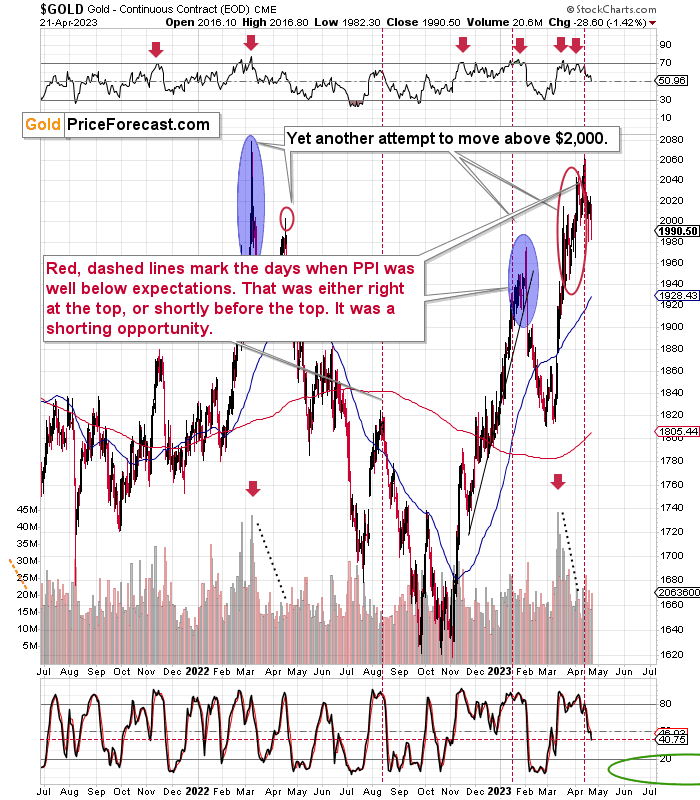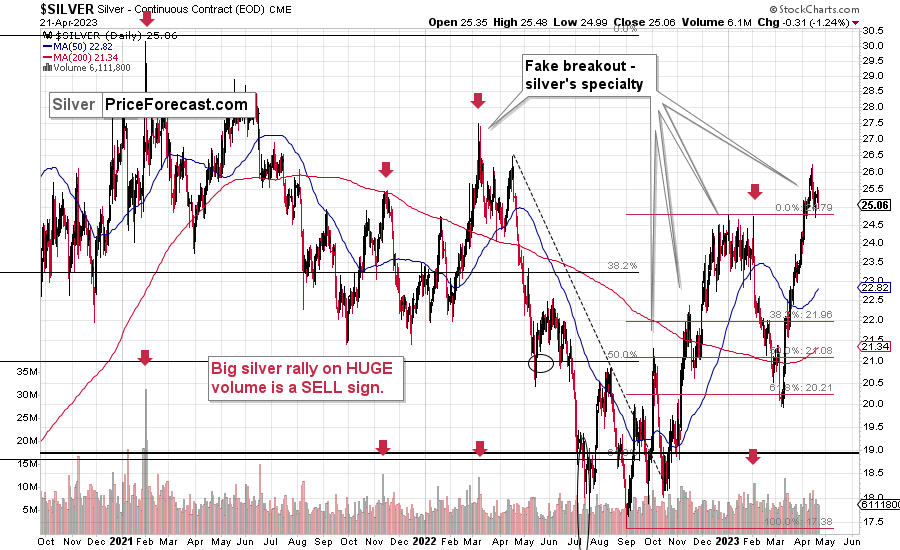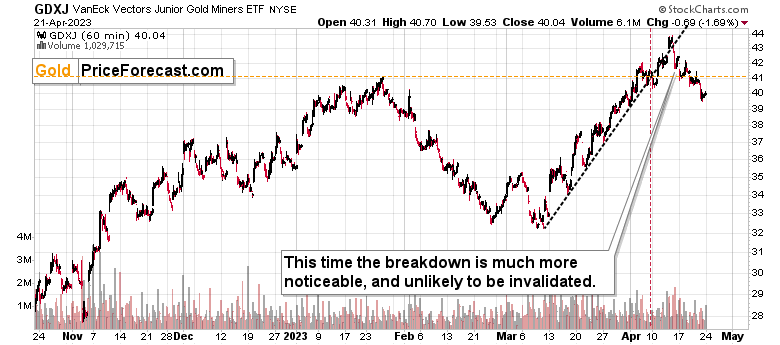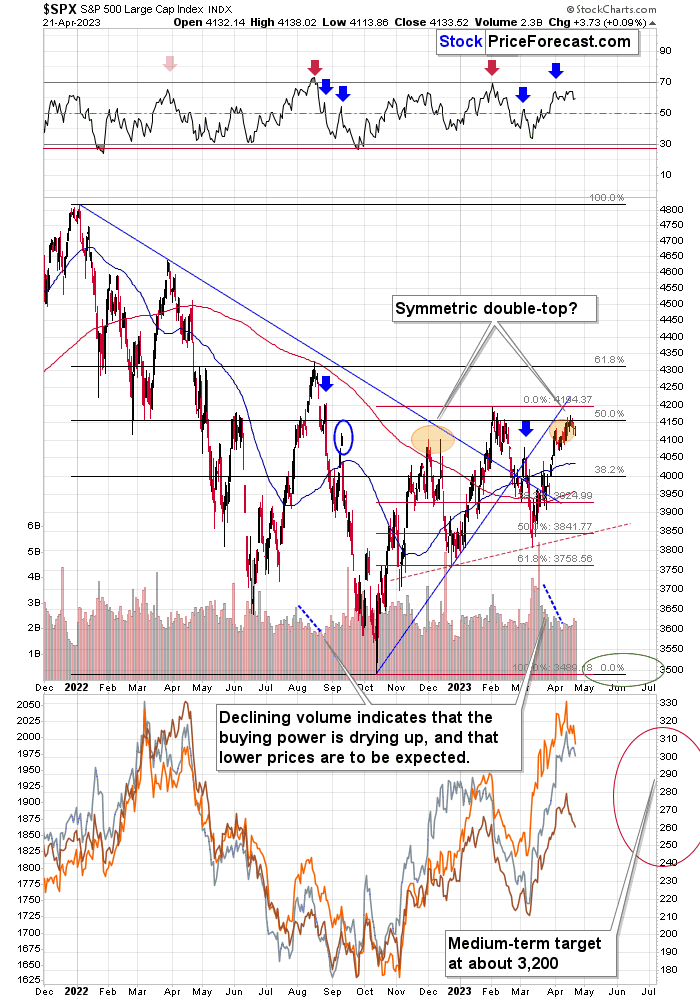Gold is currently trying to test the $2000 level again, but last week's plunge below the $2,000 level provided the final confirmation. And why is this big news?
I wrote on a number of occasions that the gold price was unlikely to hold the breakout above the $2,000 level. Last week provided the final confirmation.
Gold price not only declined below $2,000 in a decisive manner. It not only closed the day below this level. It even closed the week below it.
And that’s big news.

Weekly price moves tend to be much more important than daily ones as they are better for filtering out the “price noise” caused by events and triggers that are important only at the first sight.
Based on my analysis of gold prices over the past decades, weekly closing prices tend to be particularly important. Thus the fact that gold managed to move below those levels has particularly bearish implications.
And it’s not just a breakout above $2,000 that was just invalidated in this important manner. It was also the breakout above the April 2022 high that was just canceled. The fact that it all happened similarly to what we saw last year at the same time of the year only adds to the bearish mix.
Yes, last year, gold prices didn’t manage to move to short-term highs in April, but when looking at volume levels and how they changed over time, the similarity becomes more apparent. Namely, gold soared on huge volume at first, then the volume declined while gold consolidated/declined, and the final upswing in gold price caused an upswing in volume – but a barely visible one. And the final top formed in April.
Well, here we go again. The forecast for gold price is currently very bearish based on the above alone, but there are many other factors pointing to lower gold prices as well.
Silver prices, for example, soared significantly recently, and they even showed strength on a very short-term basis by not declining below their previous highs even though gold did.

I’ve emphasized it numerous times in the past, but it’s worth repeating once more. The fact that silver outperformed its yellow counterpart is not a bullish indication. Conversely, that’s something that we’ve seen many times in the past.
Remember the early-2021 when silver soared, but gold hasn’t? That was not just the start of a short-term decline in silver. It was the beginning of a 2+ year decline that is still taking place.
Silver price breakouts are not to be taken at their face value as well. The white precious metal is known for its tendency to break out above its previous highs, exciting those who are new to the silver market and/or investing/trading in general, and then sliding profoundly to the said investors’ / traders’ surprise (and disappointment.
It seems that silver tends to attract the investment public that buys into this market at the final stage of a given rally. There might be multiple reasons for it, and I don’t want to cover all of them here, but one of them is the simple fact that the silver market is much smaller than the gold market, thus, it’s impossible to enter the silver market by many big institutions.
It is available for small investors, though. Consequently, it’s normal to expect more individual investors in the silver market than big institutions. And since individual (especially beginning) investors tend to follow the emotionality of the market more so than institutions do, we can notice the above-mentioned pattern.
Anyway, all the current analysis of silver prices implies that silver breakouts should not be trusted on their own – additional confirmations from other markets are necessary to validate them. And in case of their absence, one could even view silver breakouts as good shorting opportunities. Of course, one needs to be careful in case of any trading position, limit their positions, and consider other indicators/factors. Still, the fact is that silver breakouts very often turn into “fakeouts.”
So, even though it might seem otherwise, the silver price forecast is currently bearish, not bullish. This is especially the case that instead of seeing a bullish confirmation from mining stocks… We saw a bearish one.

While silver remained above its previous 2023 high, the VanEck Junior Gold Miners ETF (NYSE:GDXJ) ETF – a proxy for junior mining stocks – moved decisively lower in a sharp manner. It managed to close the week only a few cents above the $40 level. It’s not important that it closed above $40; what is important is that it closed the week well below the January 2023 highs.
This confirms the invalidation that we saw on the gold market.
If we saw this move on its own, it would be very bearish, but since it’s combined with gold’s invalidation and silver’s relative strength, it’s super-bearish for the following weeks.
Is it bearish also for the following days? It might be, but it doesn’t have to be. Let’s keep in mind that no market can move up or down in a straight line, and periodic corrections will happen regardless of the strength of the primary move.
Still, the current picture for the precious metals sector is very bearish because it managed to move lower and invalidate the breakdowns practically without the help of the markets that usually impact its moves.
One of those markets is the general stock market.

Stocks didn’t move at all (almost) on Friday, and it didn’t prevent mining stocks from falling. And let’s keep in mind that mining stocks are… Well… Stocks. In particular, junior mining stocks tend to be more linked with the performance of the general stock market than senior miners do.
Yet, junior miners declined visibly pretty much on their own. This tells us that the precious metals market just can’t wait to decline more. And since the forecast for stock prices is bearish in my view, it seems that juniors will get a very bearish “extra push” in the following days/weeks.
Why would the outlook for stock prices be bearish? Because the interest rates are already high and still likely to rise (yes). Likely more than most people currently anticipate, which means that the market is likely to be negatively surprised by those moves.
And this is a global phenomenon that’s likely to affect other countries as well, likely causing a decline in commodity prices. So, yes, I’m currently forecasting lower oil prices as well. Not necessarily (it could happen soon, though) today or in the following week, but in the following months.
What about the currency markets? The USD Index is one of the two key fundamental drivers of gold prices (the other one is the level of real interest rates), so let’s check what just happened in it.

Pretty much nothing happened in it on Friday. It declined by 0.01, which means that it was practically flat. Yet, gold declined and ended the week well below the $2,000 level. This shows that gold – just like mining stocks – just can’t wait to decline here.
This is bearish for the gold price on its own, but when we combine it with the likelihood for the USD Index to move higher, it becomes obvious that gold can truly slide in the following weeks.
Why would the current forex forecast for the USD Index be so bullish?
There are many long-term reasons, but looking at the above chart, we see one short-term example: the USD Index just invalidated its small breakout below its previous yearly low. This is a very bullish indication.
Additionally, the situation in the RSI indicator is currently very similar to what we saw in mid-2021 before the massive rally.
And since the correlation between gold and the USD Index is so strongly negative (you can see it at the bottom of the above chart) and gold and the USDX have been indeed moving in the opposite directions for more than a year now, the bullish outlook for the USD Index is very bearish for the precious metals market.
